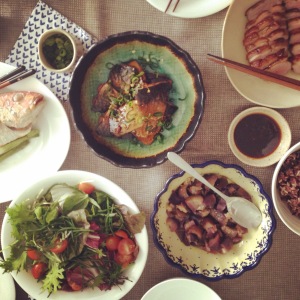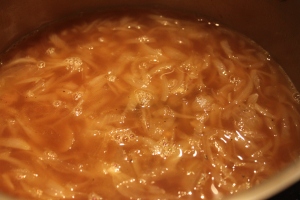
“Raindrops keep falling on my head…I ain’t gonna stop the rain by complaining.
I’m dancing and singing in the rain…why am I smiling?
Because I am living a life full of you.” – I love Vancouver.
Brunching in “Raincouver”….walking in the rain in Gastown and brunching at L’abattoir…it’s always great to revisit old favourites.

Attended our friend’s wedding (congratulations Bryan and Adelphie) on Halloween (that’s a first!!)
Spent time cooking and experimenting at home….
My take on “Fish without Chips”: Baked lemon pepper panko crusted cod : Last month I adapted Just One Cooking’s baked croquettes method and made some fabulous kabocha edamame croquettes at home; using the same stove-top browning method to prepare the panko (a little olive oil and medium low heat on a frying pan), I encrusted the beautiful cod I got from Seafood City (Granville Island Public Market) with lemon rind browned panko mix (flour/egg/panko), baked the fish in 350 degree F oven for approximately 10 minutes..served piping hot on a homemade relish mayo sauce (OJAI lemonaise + greek yogurt + homemade relish)…now I just have to get those “yam fries” in next time (OO)
It has been a while since I made Saba (mackerel) Soboro (Flaked Mackerel with carrots, onions and scrambled egg, check my recipe posting in the archives February 2014)…This one is for you: Shin, Teru and Rinka, we miss you!
http://www.granvilleisland.com
Life is always full of wonderful little surprises and always give us something to think about: GROW – COOK – SHARE – ADVOCATE
Two months ago I entered and won the Gastropost Vancouver “Good Food Changes Lives” contest via Instagram with my savoy cabbage salad photo.
Warm Savoy Cabbage and Radicchio Salad with toasted pine nuts, dried cranberries, pancetta bits, parmesan Reggiano and a drizzle of homemade honey balsamic vinaigrette (1 Tablespoon manuka honey, 2 Tablespoon balsamic vinegar, 1/4 cup extra virgin olive oil, sea salt and black pepper season to taste)
The most meaningful prize gift basket came in early November; thank you thank you thank you Gastropost Vancouver and Community Food Centres Canada for your truly inspirational handwritten message and thoughtful gifts; I’m inspired to share my table and make a difference.
http://www.vancouver.gastropost.com
We are always learning something new:
My friend PPQ and I attended a Nutrition Education Seminar hosted by the BC Cancer Agency two weeks ago at their Vancouver Research facility. The presentation by key speaker Ms. Desiree Nielsen RD is informative and delightful (she’s a lovely speaker); Ms. Nielsen provided 10 simple steps to “unjunk our diets”, her insights and guidelines are geared towards preventing inflammation and general overall health improvement for everyone. I’m planning to read her book “Unjunk your diet” and research further..
And when the “dining” stars were aligned: Posh Noshing at Torafuku, the #CoolestCatOnTheBlock (958 Main Street, Vancouver tel 778-903-2006)
Finally we made it to Torafuku, “brick and mortar” location by the creators of Le Tigre food truck
2 cocktails for him + 1 mocktail for me + 4 great dishes + 1 scrumptious dessert + great service + friendly conversation with the bartenders = We will be back


Back to Ramen Butcher in Chinatown..this time for tsukemen (Check out their campaign specials on instagram)
http://www.theramenbutcher.com

Although my heart goes out to Paris...
There’s always lots happening in my city:
Can you decipher the message? It echoes my sentiments towards “Raincouver”…
(Maggie, thank you for being the coolest teacher)
LOVE YOU TO THE MOON AND BACK….



































































